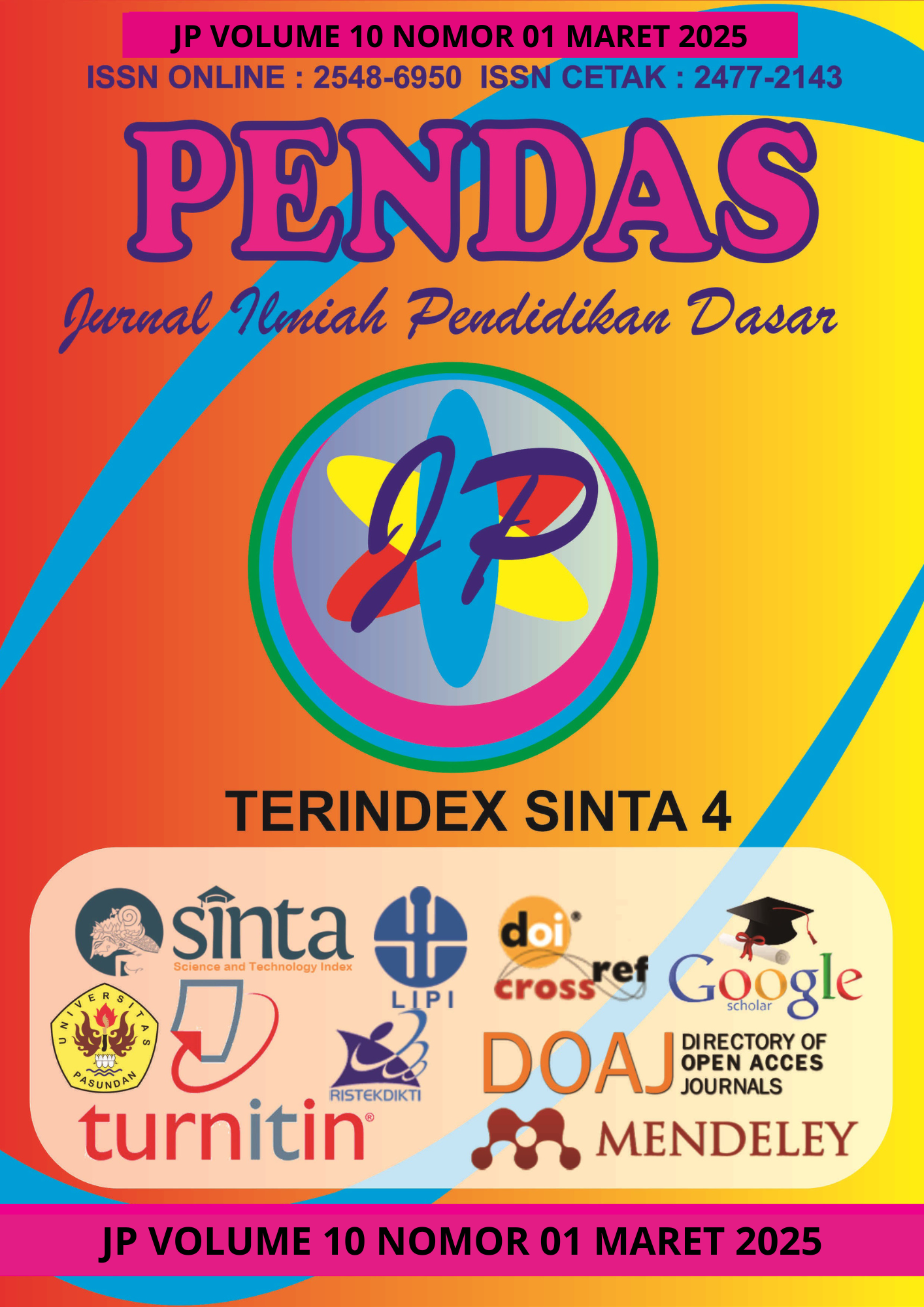PENDEKATAN CULTURALLY RESPONSIVE TEACHING (CRT) DALAM MENSTIMULASI KEMAMPUAN BERFIKIR KREATIF SISWA PADA PEMBELAJARAN MATEMATIKA MATERI BANGUN RUANG DI MADRASAH IBTIDAIYAH
DOI:
https://doi.org/10.23969/jp.v10i01.21817Keywords:
culturally responsive teaching (CRT) approach, creative thinking, mathematics, building space, madrasah ibtidaiyahAbstract
This study aims to analyze the application of Culturally Responsive Teaching (CRT) approach in stimulating the creative thinking ability of grade 1 madrasah ibtidaiyah students on the material of recognizing the shape of space. Using qualitative method with ethnographic approach, this research highlights the integration of local cultural values through contextual media in the form of traditional food, interactive technology such as wordwall, and problem-based learning model. Data were collected through observation, interviews, and documentation, with data analysis following the Miles and Huberman model. Data validity was based on triangulation of techniques and sources. The results showed that the Culturally Responsive Teaching (CRT) approach in stimulating the creative thinking ability of grade 1 madrasah ibtidaiyah students on the material of recognizing the shape of a space, including: (1) students can identify spatial shapes through objects such as onde-onde (ball), layer cake (block), and diamond cake (cube); (2) students are able to see spatial shapes from various perspectives, both through concrete and digital media, (3) students show creativity by associating spatial shapes with other objects around them; (4) students can develop ideas in detail and complete challenges on the wordwall. Overall, the CRT approach helps students understand the concept of building space in a relevant, meaningful way, and supports the development of creative thinking skills holistically.
Downloads
References
Abidin, J., Rohaeti, E. E., & Afrilianto, M. (2018). Analisis Kemampuan Berfikir Kreatif Matematis Siswa SMP Kelas VIII Pada Materi Bangun Ruang. JPMI Dinila, H. S., Sundari, F. S., & Nurjanah, S. (2024). Penerapan Pendekatan Culturally Responsive Teaching (CRT) Berbantuan Media Wordwall untuk Meningkatkan Motivasi Belajar Peserta Didik Kelas IV di SDN Bondongan. Pendas: Jurnal Ilmiah Pendidikan Dasar, 9(2), 4380–4389. https://doi.org/10.23969/jp.v9i2.14230
Amelia, S. R., & Pujiastuti, H. (2020). Analisis Kemampuan Berpikir Kreatif Matematis melalui Tugas Open-Ended. JPMI: Jurnal Pembelajaran Matematika Inovatif, 3(3), 247–258. https://doi.org/10.22460/jpmi.v3i3.p%25p
Andiyana, M. A., Maya, R., & Hidayat, W. (2018). Analisis Kemampuan Berpikir Kreatif Matematis Siswa SMP Pada Materi Bangun Ruang. JPMI (Jurnal Pembelajaran Matematika Inovatif), 1(3), 239–248. https://doi.org/10.22460/jpmi.v1i3.p239-248
Enjelina, R. F., Damayanti, R., & Dwiyanto, M. (2024). Penggunaan Pendekatan Culturally Responsive Teaching (CRT) untuk Meningkatkan Hasil Belajar Matematika Siswa Kelas V SD. Edutama: Jurnal Ilmiah Penelitian Tindakan Kelas, 1(1), 39–51. https://doi.org/10.69533/t35nhb59
Fahri, J., & Setyaningrum, V. (2023). Analisis Kemampuan Berpikir Tingkat Tinggi Peserta Didik Materi Volume Bangun Ruang. J-PiMat: Jurnal Pendidikan Matematika, 5(1), 743v754. https://doi.org/10.31932/j-pimat.v5i1.2392
Firdausy, I. A., Pratiwi, D. E., & Hastungkoro, H. N. A. (2024). Penerapan Model Project Based Learning Melalui Pendekatan Culturally Responsive Teaching untuk Meningkatkan Hasil Belajar Matematika Kelas 1 di SDN Putat Jaya IV-380 Surabaya. Journal of Science and Education Research, 3(2), 37–42. https://doi.org/10.62759/jser.v3i2.127
Fitria, F., & Saenab, S. (2023). Peningkatan Hasil Belajar IPA Peserta Didik Menggunakan Pendekatan Culturaly Responsive Teaching di SMP Negeri 1 Pallanga. Jurnal Pemikiran dan Pengembangan Pembelajaran, 5(2), 1004–1008. https://doi.org/10.31970/pendidikan.v5i2.661
Gay, G. (2015). The What, Why, and How Of Culturally Responsive Teaching: International Mandates, Challenges, and Opportunities. Multicultural Education Review, 7(3). https://doi.org/10.1080/2005615X .2015.1072079
Girsang, B., Maryanti, I., & Nasution, U. (2024). Penerapan Model PBL Terhadap Hasil Belajar Siswa Melalui Pendekatan CRT. Journal Mathematics Education Sigma [JMES], 5(2), 162–169. https://doi.org/10.30596/jmes.v5i2.20786
Haryanti, N. D., Nursyahidah, F., & Luthfisari, D. (2024). Penerapan Culturally Responsive Teaching Berbantuan Video Interaktif untuk Meningkatkan Hasil Belajar Kelas 2 Materi Cerita Rakyat. EDUTECH: Jurnal Inovasi Pendidikan Berbantuan Teknologi, 4(3), 200–208. https://doi.org/10.51878/edutech.v4i3.3309
Hernita, L. V., Istihapsari, V., & Widayati, S. (2024). Peningkatan Pemahaman Konsep Matematika Siswa Kelas XI-2 SMAN 2 Bantul dengan Pendekatan Culturally Responsive Teaching (CRT) Berbantuan Google Sites. Proximal: Jurnal Penelitian Matematika dan Pendidikan Matematika, 7(2), 424–430.
Khasanah, I. M. (2023). Effectiveness of Culturally Responsive Teaching (CRT) Approach to Increasing The Learning Outcomes of Class II Elementary School Students. Alifbata: Jurnal Pendidikan Dasar, 3(2), 7–14. https://doi.org/10.51700/alifbata.v3i2.514
Kurniasari, I. F., Dwijayanti, I., Roshayanti, F., & Handayani, S. (2023). Implementasi Culturally Responsive Teaching pada Materi Bentuk Bangun Ruang Kelas 1 SDN Pandean Lamper 04 Semarang. JIIP-Jurnal Ilmiah Ilmu Pendidikan, 6(7), 5364–5367. http://dx.doi.org/10.54371/jiip.v6i7.2403
Lahisa, A. I. Y., Asih, S. S., & Hilda, E. M. (2024). Meningkatkan Hasil Belajar IPAS Materi Indonesia Kaya Budaya Melalui Pendekatan CRT dengan Berbantuan Media Wordwall pada Siswa Kelas IV SDN Banyumanik 01 Tahun Ajaran 2023/2024. Prosiding Webinar Penguatan Calon Guru Profesional, 28–40. https://proceeding.unnes.ac.id/wpcgp/article/view/3345
Laily, N. I., Ismiati, R., Rosyidi, A. H., Mandala, A. S., & Hanjarwati, R. (2024). Implimentasi Model Prolem Based Learning Berbasis Culturally Responsive Teaching (PBL-CRT) Untuk Mengembangkan Kemampuan Berpikir Kreatif Matematis Siswa. Pendas: Jurnal Ilmiah Pendidikan Dasar, 9(2), 3712–3721.https://doi.org/10.23969/jp.v9i2.13977
Muttaqin, M. Z., Siswono, T. Y. E., & Lukito, A. (2020). Pengembangan Multimedia Lectora Inspire untuk Meningkatkan Kemampuan Berpikir Kritis dalam Menyelesaikan Soal Cerita Bangun Ruang. Jurnal Cendekia: Jurnal Pendidikan Matematika, 4(2), 495–511. https://doi.org/10.31004/cendekia.v4i2.259
Rahmanda, A., Agusdianita, N., & Desri, D. (2024). Penerapan Pendekatan Culturally Responsive Teaching (CRT) dalam Kegiatan P5 di SDN 67 Kota Bengkulu. In Social, Humanities, and Educational Studies (SHES): Conference Series, 7(3), 54–62. https://doi.org/10.20961/shes.v7i3.91500
Ramandani, R. (2019). Proses Koneksi Matematis Siswa erdasarkan Level Berpikir Kreatif (Doctoral Dissertation, Universitas Negeri Malang).https://repository.um.ac.id/110940/
Prastyo, D., & Wulandari, F. E. (2023). Effect of Booklets Based on Project Based Learning on Solving Environmental Problems in Junior High Schools. Jurnal Penelitian Pendidikan IPA, 9(2), 698–705. https://doi.org/10.29303/jppipa.v9 i2.2612
Rahmawati, R. A., Apriandi, D., & Purwaningtijas, P. (2024). Penerapan Pendekatan Culturally Responsive Teaching (CRT) dengan Model Pembelajaran Problem Based Learning untuk Meningkatkan Kemampuan Berpikir Kritis Peserta Didik. In Seminar Nasional Sosial, Sains, Pendidikan, Humaniora (SENASSDRA), 3(3), 523–529.
Setiyani, & Winanto, A. (2024). Peningkatan Kemampuan Pemecahan Masalah Matematika Melalui Model Problem Based Learning dengan Pendekatan Culturally Responsive Teaching. Jurnal BELAINDIKA: Pembelajaran dan Inovasi Pendidika), 6(2), 205–215. https://doi.org/10.52005/belaindika.v6i2.171
Sugiyono. (2017). Metode Penelitian Kuantitatif, Kualitatif dan R & D. Bandung: Alfabet.
Downloads
Published
Issue
Section
License
Copyright (c) 2025 Pendas : Jurnal Ilmiah Pendidikan Dasar

This work is licensed under a Creative Commons Attribution 4.0 International License.



















